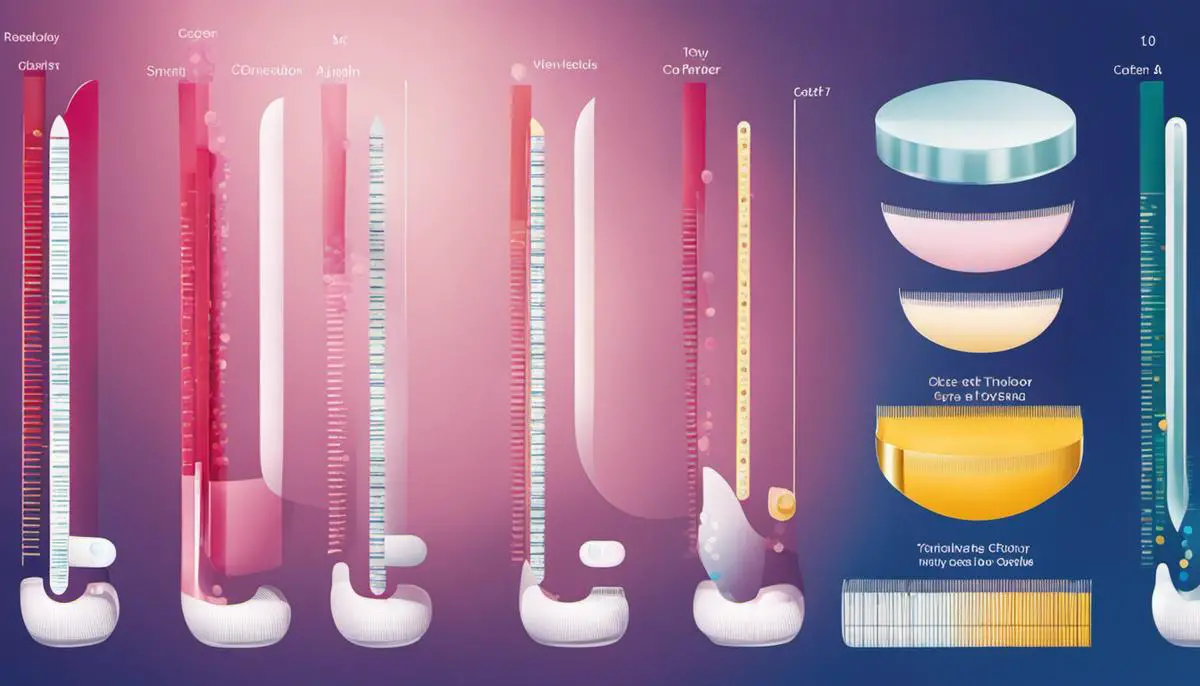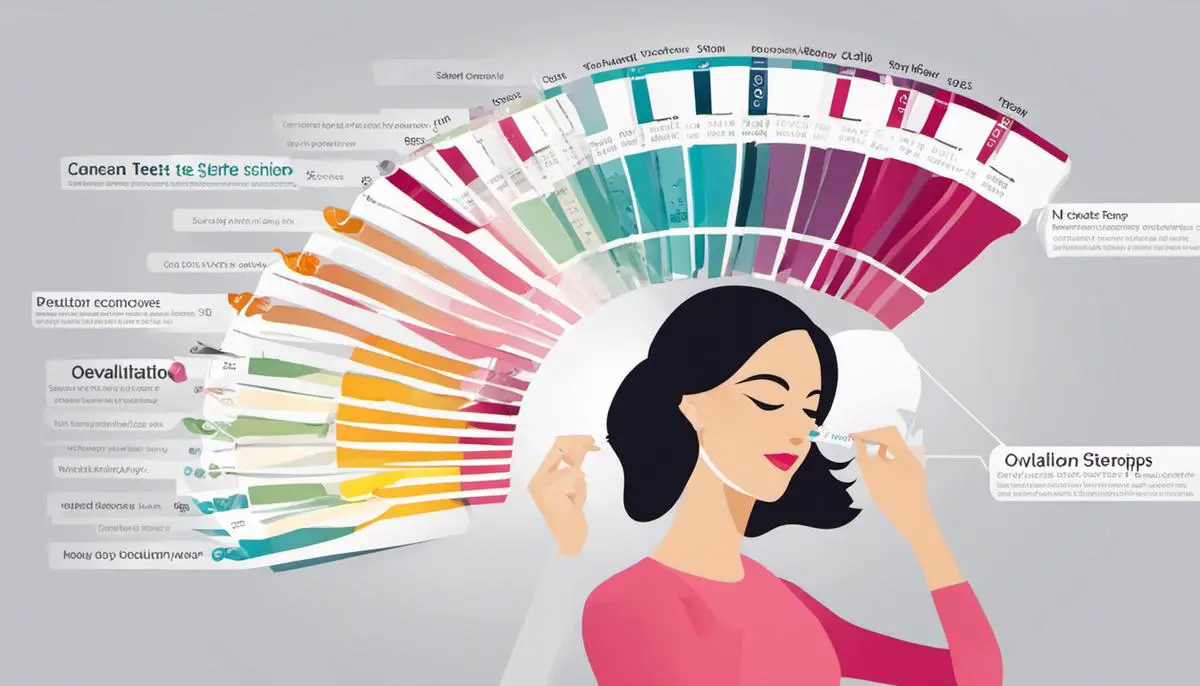Finding the optimal time for conception can be a crucial part of planning a pregnancy, and ovulation test strips play a vital role in detecting the most fertile period in a woman’s menstrual cycle. These handy tools operate on the principle of identifying the surge in Luteinizing Hormone (LH), which triggers ovulation. Understanding the ins and outs of these handy tools, such as their type, usage, reliability, and the specific features offered by various brands, can help individuals navigate their fertility journey with more ease and confidence. This article aims to provide a comprehensive picture of ovulation test strips, simplifying the process of choosing the right one for you.
Basics to Understanding Ovulation Test Strips
Understanding Ovulation Test Strips
Ovulation test strips are tools designed to help women identify the part of their menstrual cycle when they are most likely to conceive. These strips are used to detect the surge in luteinizing hormone (LH) levels that typically occurs just before ovulation. The surge in LH triggers the release of an egg from the ovaries, marking the start of the ovulation period.
How Ovulation Test Strips Work
These test strips work by detecting the presence and concentration of LH in urine. When the strip is immersed in a sample of urine, it tests for the presence of LH. If the LH level is high enough, it indicates that ovulation is likely to occur within the next 24 to 36 hours. The process of waiting for a positive result, usually indicated by a particular color or symbol on the test strip, can be likened to a typical pregnancy test.
Differences in Ovulation Test Strips
Although all ovulation test strips share the same fundamental purpose and operating principle, there are differences between various brands and types of strips. Some of these differences can be seen in the sensitivity of the strips, the method of displaying results, and the number of strips included in a package.
Sensitivity of Ovulation Test Strips
Sensitivity of ovulation test strips refers to the minimum concentration of LH that a strip can detect within a urine sample. While most strips can detect LH concentrations of about 25 mIU/mL, some high-sensitivity variants can detect even lower LH levels, as low as 10 mIU/mL. This may be particularly beneficial for women who have lower than average LH levels, offering them a more accurate opportunity to predict ovulation.
Display Method
The way results are displayed can also vary across different brands and types of ovulation test strips. While some display results as lines of varying intensity, akin to a pregnancy test, others may use digital screens that show results in words or symbols. Some digital tests can also track changes in LH levels over time, allowing for a more comprehensive overview of the ovulation cycle.
Package Size
Another key difference among ovulation test strips is the number of strips included in a package. While some manufacturers offer packs of 5 or 10, others may offer bulk packages that contain 50 or more. The number of strips in a pack can influence the cost-effectiveness and suitability for different users depending on their testing needs.
To conclude, gaining a deep understanding of the distinct differences between ovulation test strip types can significantly assist individuals in making informed decisions. Such decisions are based on personal needs and specific circumstances when choosing the most suitable ovulation test strips.

Types of Ovulation Test Strips
Different Ovulation Test Strip Varieties
Ovulation test strips or ovulation predictor kits (OPKs) play a crucial role in determining when a woman’s chances of conception are highest. These kits operate by monitoring the concentration of luteinizing hormone (LH) present in a woman’s urine. An LH surge generally occurs 24-48 hours prior to ovulation, which is the ideal time for conception. Test strips usually feature two lines. The control line, which remains consistently dark, and the test line, which grows darker once an LH surge is detected.
Digital vs Non-Digital Ovulation Test Strips
There are two broad types of ovulation test strips – digital and non-digital.
Digital ovulation test strips offer a certain level of convenience over non-digital strips. These digital tests often feature a digital reader that interprets the results for you and displays them on a digital screen, eliminating the need to interpret line colors. They usually appear as a smiley face for a positive result, or an empty circle for a negative. Many digital test kits also have the functionality to store data from several cycles, which may prove beneficial to women tracking their ovulation pattern over multiple months.
On the other hand, non-digital ovulation test strips require a user to compare the color of the test line to a control line to interpret the results. When LH levels are high, the test line will be as dark or darker than the control line. They do not store data and each strip is for a single-use only. Non-digital strips are typically less expensive than their digital counterparts.
Accuracy and Sensitivity
The accuracy and sensitivity of ovulation test strips can vary. Some tests are more sensitive and can detect lower levels of LH, which could potentially detect the onset of the LH surge sooner. However, it is important to note that a more sensitive test won’t necessarily result in a successful pregnancy sooner, as it might simply detect the LH surge earlier in the same ovulation cycle.
Choosing the Best Ovulation Test Strip for You
Deciding on whether to use a digital or non-digital ovulation test strip is often influenced by various considerations. Some women find the unambiguous, easy-to-read results provided by digital tests more appealing, particularly if reading line colors is a bit of a hurdle. On the other hand, some might opt for non-digital versions due to their lesser expense and the autonomy they provide when interpreting the results.
Regardless of the type, it’s key to note that both kinds of ovulation test strips serve the same function: they aid a woman in discerning her most fertile days in her cycle. This can be a crucial aid for those attempting to fall pregnant, providing invaluable information about when ovulation is likely to occur.

Accuracy and Effectiveness of Ovulation Test Strips
Specifications Regarding the Accuracy of Ovulation Test Strips
Ovulation tests work by identifying a surge in the Luteinizing Hormone (LH), which usually takes place 12 to 36 hours prior to ovulation. These extremely sensitive strips are capable of detecting even slight increases in LH levels, as low as 25 mIU/ml. They boast an impressive accuracy rating of roughly 99%, making them a dependable resource for predicting ovulation.
Nevertheless, several variables can affect the accuracy of these test strips. Factors include the timing of the test, the concentration of your urine, and how one decipher the results. Testing too early in your menstrual cycle or too late in the day may result in a false negative, as LH surges generally occur early in the day. The potency of your urine is also crucial, as diluted urine can yield false negatives. Inaccurate interpretations of the results can affect the test’s accuracy as well. For example, a positive outcome is indicated if the test line is similar in color density or darker than the control line.
Effectiveness of Ovulation Test Strips
While ovulation test strips have high accuracy, their effectiveness varies widely among individuals since they utilize biological indicators that can fluctuate greatly from one woman to another. A significant number of women do not exhibit a noticeable surge in LH before ovulation, making the strips less effective for them.
Also, certain medical conditions like Polycystic Ovary Syndrome (PCOS) can cause elevated LH levels throughout the cycle, leading to false positives. Specific fertility medications can also impact the LH levels, which can alter the results.
Misconceptions and Limitations
While they are a useful tool, ovulation test strips shouldn’t be solely relied upon for determining the optimal time for conception. Notably, a positive result on an ovulation test strip does not guarantee conception.
This is because a positive result merely indicates that the body is preparing for ovulation, but it does not confirm that ovulation will occur. Similarly, ovulation test strips cannot confirm whether ovulation has already occurred. They are not capable of detecting pregnancy and should not be used as a pregnancy test.
Additionally, issues such as early-stage menopause, recent use of birth control pills, and breastfeeding might give false results as they alter the LH levels in the body. The test strips should always be stored in a cool, dry place as improper storage can affect their performance.
Ovulation Test Strips: An Integral Part of Fertility Awareness
Ovulation test strips play an essential role in predicting ovulation as a part of an extensive fertility awareness plan. However, they are just one piece of the puzzle. It’s equally crucial for women aiming to conceive to consistently monitor other fertility signals, such as fluctuations in basal body temperature and cervical mucus changes.

Comparing Brand Differences
A Closer Look at Different Ovulation Test Strip Brands
Now that we understand the importance of ovulation test strips in a fertility awareness strategy, let’s unpack the specifics of different brands. By assessing each based on key factors like ease of use, accuracy, value for money, and user reviews, we can better comprehend their individual strengths and differences.
Clearblue Digital Ovulation Test Strips
Clearblue offers digital ovulation test strips that can track two fertility hormones. Many users appreciate their digital display feature since it eliminates interpreting lines’ darkness. The brand’s claim to fame is a 99% accuracy rate in detecting luteinizing hormone (LH) surge, making it a trusted choice among many. However, these tests are more expensive compared to other brands.
Easy@Home Ovulation Test Strips
Easy@Home is known for cost-effectiveness, offering 50 ovulation (LH) test strips and 20 pregnancy (HCG) test strips in one package. It provides manual test strips requiring users to interpret lines, which some may find daunting. Nonetheless, they boast a significant sensitivity level to detect LH increase and have a solid user rating for their accuracy and affordability.
Pregmate Ovulation Test Strips
Pregmate provides an abundant offering with 50 ovulation test strips and 20 pregnancy test strips. The brand suggests a 99% accuracy, making it a trustworthy option. However, it is a line interpretation test that might not be ideal for all users. On the brighter side, it is moderately priced, merging accuracy and affordability.
ClinicalGuard Ovulation Test Strips
This brand is noted for its user-friendly approach and budget-friendly pricing. It offers simple, no-frills test strips that identify an LH surge with reasonable accuracy. Despite their lack of digital display, these tests win over many due to their cost-effectiveness.
First Response Ovulation Test Strips
First Response offer test strips with digital readings, doing away with the complexities of line interpretation. Besides, they test for both LH and estrogen levels, providing a broader fertility window. The brand advocates a 99% accuracy rate. However, these comprehensive features come with a higher price tag.
The varied brands of ovulation test strips serve different preferences and budgets. Some users might prefer line interpretation tests for their simplistic design and lower cost, while others may opt for digital tests for easier interpretation. In terms of accuracy, most brands promise around a 99% accuracy rate, though user reviews suggest minor variations.

Armed with the knowledge gained in this article’s various sections – basics of ovulation test strips, types, accuracy and comparison of different brands, you will find it much easier to choose the right ovulation test strip that best meets your needs. Remember, the perfect test strip is one that gives you accurate results, is easy-to-use, and fits your budget. If it ticks these boxes, it will significantly aid in your journey towards conception. Good luck on your path towards parenthood!
